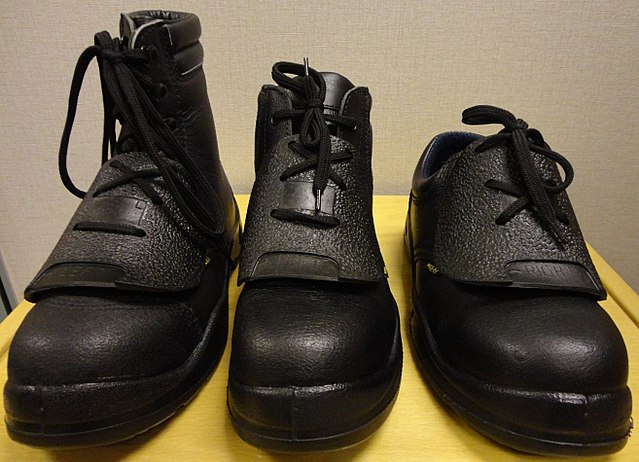Loading AI tools
Footwear reinforcement From Wikipedia, the free encyclopedia
A steel-toe boot (also known as a safety boot, steel-capped boot, steel toecaps or safety shoe) is a durable boot or shoe that has a protective reinforcement in the toe which protects the foot from falling objects or compression. Safety shoes are effective in keeping the feet of industrial workers safe from sharp and heavy objects while working in factories.[1]


Safety footwear now comes in many styles, including sneakers, clogs, and dress shoes. Some are quite formal, for supervising engineers who must visit sites where protective footwear is mandatory.[2]
Some brands of steel-toe footwear have become fashionable within subcultures such as skinhead, punk, and rivethead. While brands that were previously renowned within the fashion industry have also diversified into the safety footwear market, industrial brands like Caterpillar, Rock Fall and JCB have also issued licenses to produce safety footwear.
Safety boots are used by tradespeople to protect from environmental hazards at a jobsite. They may also be used for outdoor recreational activities or sports such as off-roading, overlanding or woodchopping. Common protections include steel/reinforced toe, metatarsal guard, penetration-resistant (steel plate in mid-sole), electrical hazard (EH), chemical resistance and waterproofing.[3] Modern safety boots are usually laced with a vertical side zipper under a hook-and-loop strap.[4]

Safety shoe standards in Asia are:



The International Organization for Standardization provides the European standard for safety footwear. The current one is ISO 20345:2011 - previously ISO 20345:2004.
The codes applicable to European safety footwear are:
| Protected area | Type of protection | Code |
|---|---|---|
| Steel toe | Basic Impact 200 joules including compression 15,000 newtons | SB |
| 200 joule toecap protection. Closed seat region (fully enclosed heel). Antistatic properties. Energy absorption of seat region. Fuel resistance. | S1 | |
| 200 joule toecap protection. Closed seat region (fully enclosed heel). Antistatic properties. Energy absorption of seat region. Fuel resistance. Water penetration and water absorption resistance. | S2 | |
| 200 joule toecap protection. Closed seat region (fully enclosed heel). Antistatic properties. Energy absorption of seat region. Fuel resistance. Water penetration and water absorption resistance. Sole penetration resistance. Cleated outsole. | S3 | |
| Additional protections | Heat-Resistant Outsole: shoe sole resistance to hot contact up to 300 °C for 1 minute | HRO |
| Penetration resistance offered by a steel midsole: 1100 newtons | P | |
| Heel energy absorption: 20 joules | E | |
| Water penetration-resistant uppers | WRU | |
| Whole shoe waterproof | WR | |
| Metatarsal protection | M | |
| Ankle protection | AN | |
| Electrical resistance | Conductive: Maximum resistance 100 kΩ | O |
| Antistatic: Range of 100 kΩ to 1000 MΩ | A | |
| Hostile environments | Cold Insulated: shoe insulated against cold to -17 °C for 30 minutes | CI |
| Heat Insulated: shoe insulated against heat up to 150 °C for 30 minutes | HI | |
| Skid resistance on ceramic tile floors with sodium lauryl sulfate solution cleaning agent | SRA | |
| Skid resistance on steel floors with glycerine | SRB | |
| Skid resistance on ceramic tile floors with cleaning agent and steel floors with glycerine | SRC | |
| Fuel resistance (oil and gasoline/petrol) | FO | |
| Cut resistance (not against chainsaw cuts) | CR |
There is also Previous EN ISO 20346:2004 and Now the latest one is EN ISO 20346:2021[6] for protective footwear (must comply to basic safety requirements but toe cap impact resistance requirement is lower - 100 Joules) & EN ISO 20347:2004 for Occupational Footwear (must comply to basic safety requirements with antistatic or slip-resistant properties. This standard does not require a protective toe cap)

In Canada, the most common standards used by employers are those of the CSA Group (formerly the Canadian Standards Association; CSA), published in CSA standard Z195. These standards are similar to the ASTM International standards commonly used in the United States but the testing methods do vary.
CSA standards on shoe labels feature distinct shapes and colors, represents specific safety criteria for all safety footwear and apparel:
The registered symbol in each of the CSA Z195 protective footwear markings is a registered identifying logo or mark of the certifying agency.[7] Examples of organizations that certify footwear to this standard include the Safety Equipment Institute (SEI), the CSA Group, and UL Solutions.
Generally, a safety shoe is a shoe that follows at least one of five criteria. The criteria that a safety shoe adheres to can be found by looking for the CSA (Canadian Standards Association) alphanumeric code found inside the shoe. This code is made up of a combination of 5 different symbols:

In the United States, the most common standards used by employers for protective footwear are ASTM International standards F2412-18a (Standard Test Methods for Foot Protection) and ASTM F2413-18 (Standard Specification for Performance Requirements for Foot Protection).
OSHA previously required compliance of ANSI Z41.1-1991, "American National Standard for Personal Protection-Protective Footwear," if purchased after July 5, 1994,[8] or ANSI standard "USA Standard for Men's Safety-Toe Footwear," Z41.1-1967,[9] if purchased before that date.
As of March 1, 2005, ANSI Z41 has been replaced by ASTM F2412 and ASTM F2413[10]
ASTM certified footwear must include a label that indicates which safety standards that particular footwear meets. The various safety standards include:
Seamless Wikipedia browsing. On steroids.
Every time you click a link to Wikipedia, Wiktionary or Wikiquote in your browser's search results, it will show the modern Wikiwand interface.
Wikiwand extension is a five stars, simple, with minimum permission required to keep your browsing private, safe and transparent.